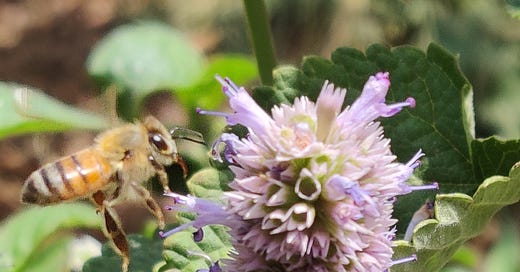Honeybee in the Learning Garden
Saving Water and the Bees!
By Sarah Harroff
If the severe drought has you reconsidering your ornamental plant choices, might I recommend a few selections that go beyond water savings? How about plants that help you maximize your BPG?
Bees per Gallon is the phrase coined by entomologist Christine Casey, Ph.D., with the UC Davis Bee Haven, a managed garden devoted to the support and study of local bees at the UC Davis campus. Having recently taken part in a five-year USDA-NIFA-SCRI-funded study to evaluate the bee-attractiveness of common landscape plants, Dr. Casey and the Haven have published this guide on which of those plants also have the lowest water needs.
While the list is based on the Central Valley region, Dr. Casey noted that they are working on a SoCal-specific plant list. Meanwhile, I’ve reviewed the study results at the Tree of Life Nursery in San Juan Capistrano and the San Diego Botanic Garden. Here are some of the least thirsty plants that got the biggest buzz at those SoCal locations.
For honey bees, toyon (Heteromeles arbutifolia), California buckwheat (Eriogonum fasciculatum), and sages, including white (Salvia apiana) and Cleveland (S. clevelandii), are popular choices with low to very low WUCOLS ratings. Taken together, these plants also offer staggered bloom periods which is an important consideration for providing year-round pollen and nectar sources.
For “other bees”, the study’s label for any of the 1,600 native bee species found foraging the flower buffet, toyon and California buckwheat make a repeat appearance. But elsewhere the two groups diverge. For example, a variety of yarrow (Achillea millefolium) called ‘Moonshine’ ranked third most favored among native bees in the San Diego garden, but only eighth among honey bees. Likewise, California sunflower (Encelia californica) took the number four spot among native bees at the Tree of Life Nursery, while only ranking tenth most favored by honey bees.
In case the distinction between honey bees and native bees is new to you, check out some of the native species you might be likely to meet in your garden here. Species that showed up in the study included our bumble, sweat, long-horned, leafcutting, and carpenter bees.
Unlike the honey bees which tend to steal the spotlight in conservation efforts, it’s the native bees that are often overlooked but most need our support. I hope these plant suggestions inspire you to be both water-wise and bee-friendly in your gardens.
Julie Mann speaking to Mr. Bailey’s Class
Venice Horticultural Program
The Venice High School Horticulture program looks forward to its second year, of its current incarnation, at the Learning Garden. Brian Bailey, our Horticulture Teacher, is working hard, with the help of many hands to keep the garden growing, maintaining plants and other items in anticipation of the students' return in August.
Many fruits and flowers that the students planted are continuing to grow and bloom. Our garden has the blessing of carrying on with activities and deep support from the community. This allows us to continue to add organic matter and biological abundance to our currently depleted soils through the summer. Many Agricultural programs are forced to stop, lose momentum and have to start all over again when students return. Our ability to continue will allow the program to grow into a dynamic and spectacular space for the students, school and the community at large
When the school year starts, Mr Bailey will have 5 Horticulture Classes, 3 introductory courses and 2 more advanced classes with returning students. These second year students will be able to tackle larger and more complex projects. He will be looking for experts and volunteers to continue the gardens’ rise to greatness.
Echinacea in the Ayurvedic garden July 2022





